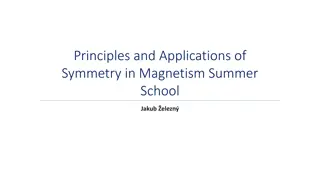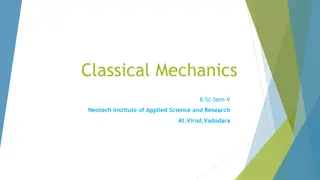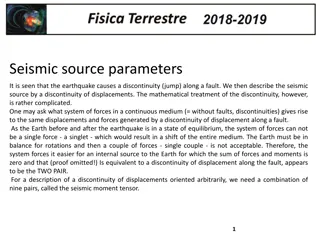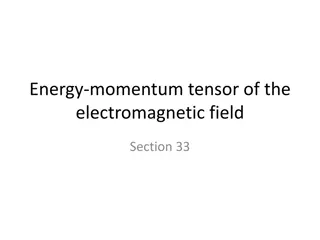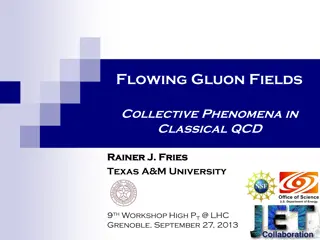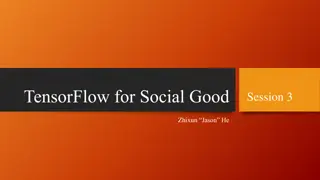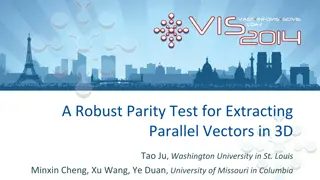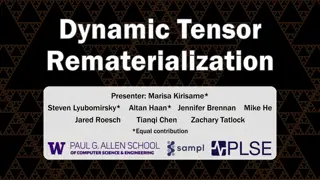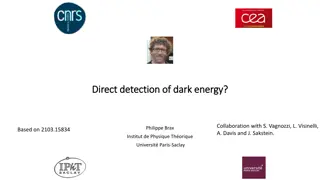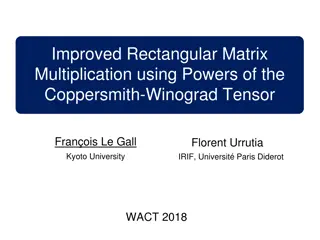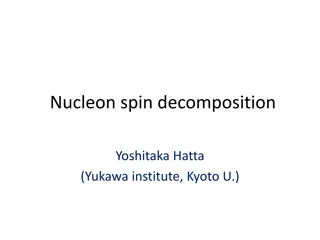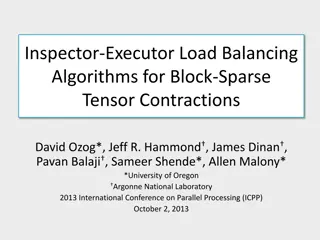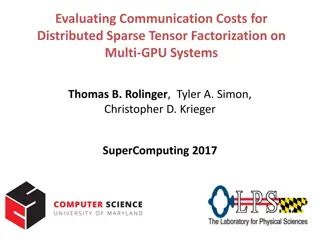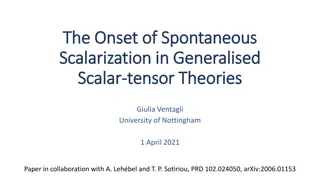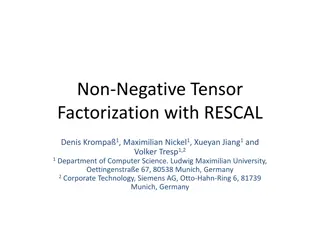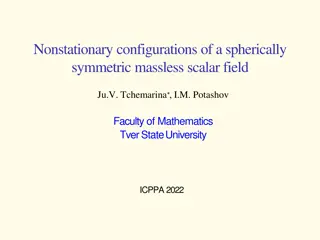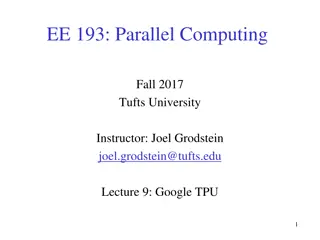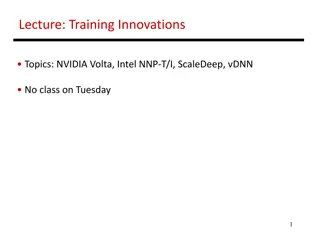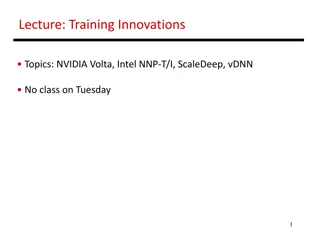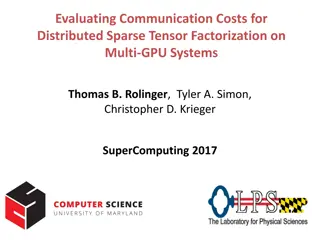Insights into Symmetry and Magnetism in Summer School Curriculum
Delve into the principles and applications of symmetry in magnetism through topics like tensor transformations, Edelstein effect, and breaking inversion symmetry in magnetic materials. Explore the role of crystal structures and interfaces in breaking symmetry, especially in antiferromagnets, providi
7 views • 39 slides
Diffusion Weighted Imaging (DWI) in Neuroimaging Research
This content delves into the significance of Diffusion Weighted Imaging (DWI) in studying the motion of water molecules in brain tissue. It explains how water diffusion varies in different brain matter types and explores techniques like Diffusion Tensor Imaging (DTI). The impact factors on diffusion
5 views • 25 slides
Classical Mechanics at Neotech Institute of Applied Science and Research, Virod
Delve into the world of Classical Mechanics in B.Sc Semester-V at Neotech Institute of Applied Science and Research, located in Virod, Vadodara. Explore topics such as motion of rigid bodies, angular momentum, Euler's theorem, inertia tensor, and Euler's equations of motion through a comprehensive s
1 views • 27 slides
Seismic Source Parameters in Earthquake Dynamics
The seismic source parameters in earthquake dynamics involve describing a fault as a discontinuity causing displacements, requiring a complex treatment of forces. The Earth's equilibrium necessitates a specific system of forces to explain displacements along faults. The seismic moment tensor, consis
7 views • 32 slides
The Energy-Momentum Tensor of the Electromagnetic Field
Exploring the intricacies of the energy-momentum tensor of the electromagnetic field, including its components, symmetries, and implications on field interactions and invariants. Delve into the mathematical derivations and transformations involved in studying this fundamental concept in electromagne
0 views • 19 slides
Nucleon Structure: Insights from EIC Workshop
Exploring the mechanics of nucleons and the physics goals of the Electron-Ion Collider (EIC), this content delves into the origin of nucleon mass and spin, emergent properties of dense gluon systems, and energy-momentum tensor in QCD. It discusses the role of gluons in understanding nucleon structur
5 views • 31 slides
Flowing Gluon Fields and Color Glass Phenomena in QCD
Explore the collective phenomena of gluon fields in classical QCD, focusing on the Standard Model of URHICs, Color Glass, and Gluon Fields in the Forward Lightcone. The research delves into topics like local thermal equilibrium, viscous hydrodynamics, and the interaction of probes with quarks and gl
3 views • 24 slides
TensorFlow for Social Good: Session Insights and Tips
Delve into Session 3 of TensorFlow for Social Good with Zhixun Jason He, covering topics such as TensorFlow model training loops, regularization techniques, tensor concepts, learning rate scheduling, and custom loss functions. Discover practical tips and valuable resources to enhance your understand
0 views • 37 slides
Robust Parity Test for Extracting Parallel Vectors in 3D
Fundamental primitives for visualizing 3D data include line features like ridges and valleys of a scalar field, stream lines of a vector field, vortices of a velocity field, and extremal curves of a tensor field. Parallel Vectors (PV) provide a unified representation of 3D line features, forming con
0 views • 27 slides
Overcoming Memory Constraints in Deep Neural Network Design
Limited availability of high bandwidth on-device memory presents a challenge in exploring new architectures for deep neural networks. Memory constraints have been identified as a bottleneck in state-of-the-art models. Various strategies such as Tensor Rematerialization, Bottleneck Activations, and G
0 views • 32 slides
Insights into Dark Energy Detection and Gravity Tests
This collaboration delves into direct detection of dark energy, evidencing acceleration in expansion and delving into the evolution of background cosmology. Gravity tests, including solar system trials, are discussed, along with models like f(R) gravity and chameleon screening in the context of scal
4 views • 20 slides
The Acceleration of the Universe and the Equivalence Principle Violation in the Horndeski Vector-Tensor Theory
Exploring the implications of the Equivalence Principle Violation after reheating in the context of the accelerated expansion of the universe. The study delves into the Horndeski vector-tensor theory, gravitational waves, and the impact of modified gravity and dark energy. Insights are provided on t
8 views • 20 slides
The Hall Effect in Conductors
The Hall Effect in conductors is described in detail, showcasing how a magnetic field affects the conductivity tensor, breaking symmetry and leading to unique properties. The discussion covers the separation of the conductivity tensor, the impact of magnetic fields on conductivity components, and th
7 views • 16 slides
Improved Rectangular Matrix Multiplication Using Coppersmith-Winograd Tensor
In this research, the complexity of rectangular matrix multiplication is enhanced by analyzing the fourth power of the Coppersmith-Winograd tensor. By extending the understanding of the tensor's power, significant advancements have been made in the efficiency of non-square matrix multiplication, sur
12 views • 25 slides
Nucleon Spin Decomposition and Proton Spin Problem
Explore the complex realm of nucleon spin decomposition and the enigmatic proton spin problem, delving into concepts like orbital angular momentum, quarks and gluons' helicity, and longitudinal double spin asymmetry in polarized deep inelastic scattering. Learn about the spin crisis, gluon polarizat
4 views • 26 slides
Dynamic Load Balancing in Block-Sparse Tensor Contractions
This paper discusses load balancing algorithms for block-sparse tensor contractions, focusing on dynamic load balancing challenges and implementation strategies. It explores the use of Global Arrays (GA), performance experiments, Inspector/Executor design, and dynamic buckets implementation to optim
3 views • 32 slides
Communication Costs in Distributed Sparse Tensor Factorization on Multi-GPU Systems
This research paper presented an evaluation of communication costs for distributed sparse tensor factorization on multi-GPU systems. It discussed the background of tensors, tensor factorization methods like CP-ALS, and communication requirements in RefacTo. The motivation highlighted the dominance o
4 views • 34 slides
Spontaneous Scalarization in Gravitational Theories
Spontaneous scalarization presents a unique phenomenon where compact objects experience field growth triggered by tachyonic instability, leading to stable field configurations. Explored in various theories, such as Horndeski gravity and scalar Gauss-Bonnet gravity, spontaneous scalarization is studi
3 views • 18 slides
Non-Negative Tensor Factorization with RESCAL
This article discusses non-negative tensor factorization with RESCAL, covering topics such as Non-Negative Matrix Factorization, Multiplicative Updates, RESCAL for Relational Learning, and Non-Negative Constraint for RESCAL. It explores how factorizing matrices/tensors into non-negative factors can
5 views • 11 slides
Nonstationary Configurations of a Spherically Symmetric Scalar Field
Action and stress-energy tensor, Einstein-Klein-Gordon equations, and method for constructing nonstationary configurations of a spherically symmetric scalar field are discussed in this study. The behavior of the characteristic function allows interpretations such as black holes, wormholes, or naked
4 views • 14 slides
Google's Tensor Processing Unit (TPU) and Deep Neural Networks in Parallel Computing
Delve into the world of Google's TPU and deep neural networks as key solutions for speech recognition, search ranking, and more. Learn about domain-specific architectures, the structure of neural networks, and the essence of matrix multiplication in parallel computing.
4 views • 17 slides
Instant Travel Time Estimation with Sparse Trajectories
This research by Dr. Yu Zheng aims to estimate travel time on road networks instantly using historical and current trajectories generated by vehicles. The methodology involves a context-aware tensor decomposition approach, optimal concatenation, and frequent trajectory pattern mining to address chal
2 views • 21 slides
Cutting-Edge Training Architecture Overview
Delve into the latest training innovations featuring NVIDIA Volta, Intel NNP-T/I, ScaleDeep, and vDNN. Learn about the impressive capabilities of the NVIDIA Volta GPU, Intel NNP-T with Tensor Processing Clusters, and Intel NNP-I for inference tasks. Explore the intricacies of creating mini-batches,
3 views • 32 slides
Recent Achievement in Regge Theory for Photoproduction of Hadron Applications
Recent breakthrough in Regge theory explores photoproduction of hadrons, applying the Regge model to understand scaling with trajectory saturation. The study delves into reaction mechanisms at high energies, introducing gauge and tensor meson exchanges. Analysis includes convergence and dominance of
2 views • 12 slides
ExTensor: An Accelerator for Sparse Tensor Algebra
Cutting-edge accelerator designed for sparse tensor algebra operations. It introduces hierarchical intersection architecture for efficient handling of sparse tensor kernels, unlocking potential in diverse domains like deep learning, computational chemistry, and more.
3 views • 23 slides
The forces on a conductor
The forces and energy interactions on a conductor in electric fields are explored, including momentum flux density, Maxwell stress tensor, and force per unit area. The direction of forces and energy density are discussed in relation to surface charge density and charges constant. Understanding the b
5 views • 21 slides
Context-aware Recommender Systems: Overview and Concepts
In this content, the Overview of COT (Contextual Operating Tensor) is presented, focusing on context-aware recommender systems. The images and related works delve into the tensor factorization and latent vectors of entities, illustrating computational procedures under different context combinations.
0 views • 22 slides
Deep Learning with Pytorch: Neural Networks and Implementation
This comprehensive guide covers neural networks, deep learning concepts, Pytorch implementation for binary and multiclass classification, GPU utilization, activation functions, loss functions, forward propagation, tensor operations, and more. Dive into the world of artificial intelligence, machine l
16 views • 24 slides
Graph and Tensor Mining: CMU SCS Insights
Discover the fascinating world of graph and tensor mining as explored by Luna Dong, Christos Faloutsos, Andrey Kan, Jun Ma, and Subho Mukherjee in the CMU SCS research. Delve into topics such as graph structures, tensors, embeddings, and inference methods showcased through visually appealing graphs
1 views • 19 slides
Cutting-Edge Training Innovations in GPU Architectures
Uncover the latest advancements in GPU architectures from NVIDIA Volta to Intel NNP-T/I, ScaleDeep, and vDNN. Dive into the details of NVIDIA Volta's tensor cores, Intel NNP-T's Tensor Processing Cluster, NNP-I's Inference Compute Engines, and the training methodologies behind these innovative techn
3 views • 23 slides
Communication Costs for Distributed Sparse Tensor Factorization on Multi-GPU Systems
Evaluate communication costs for distributed sparse tensor factorization on multi-GPU systems in the context of Supercomputing 2017. The research delves into background, motivation, experiments, results, discussions, conclusions, and future work, emphasizing factors like tensors, CP-ALS, MTTKRP, and
5 views • 34 slides
Methods for High-dimensional Tensor Factorization
Learn about distributed methods for high-dimensional and large-scale tensor factorization, a technique used to decompose tensors into core tensors and factor matrices. Discover the significance of tensor data in various applications such as context-aware recommendation and social network analysis.
4 views • 28 slides
Belief Propagation Tensor Notation Guide
Explore an alternate notation using tensors for the Belief Propagation algorithm in section 2, including tensor multiplication, marginalization, and rank-r tensor concepts. Understand the matrix-vector product, pointwise product, and more through detailed examples. Dive into the Sum-Product Belief P
1 views • 15 slides
Tensor-Optimized Antisymmetrized Molecular Dynamics
Explore the innovative Tensor-Optimized Antisymmetrized Molecular Dynamics (TOAMD) method for light nuclei with direct treatment of VNN interactions. Gain insights into the variational approach for nuclei, deuteron properties, and the formulation of TOAMD. Discover how TOAMD describes finite nuclei
2 views • 31 slides
Multipole Moments and Tensor Quantities in Physics
Explore the concept of multipole moments and symmetric tensors in physics, focusing on the expansion of potential, characterization of charge distribution, and the number of independent quantities. Learn about the relationships between various tensor quantities and their implications in field calcul
1 views • 18 slides
Testing and Extending the Inflationary Consistency Relation for Tensor Modes
This study delves into testing and extending the inflationary consistency relation for tensor modes, focusing on CMB analysis and the Big Bang Observer. It explores advancements in delensing techniques and traditional extrapolation methods, presenting a comprehensive summary of the findings.
4 views • 10 slides
Extending Inflationary Consistency for Tensor Modes
This study delves into exploring and evaluating the inflationary consistency relation for tensor modes, focusing on CMB data alone and in conjunction with the Big Bang Observer. The research delves into traditional and improved extrapolation methods to enhance the understanding of cosmological pheno
0 views • 8 slides
In-depth Look at Tensor Flow Processor (TPU) for Machine Learning and AI
Discover the power of Tensor Flow Processor (TPU) in optimizing machine learning and AI operations, as Google revolutionizes faster processing. Learn about its deployment, capabilities, and efficiency compared to traditional CPUs and GPUs.
2 views • 10 slides
Lecture on Rotational Motion in Classical Mechanics
Explore the concepts of rotational motion including rigid body motion, moment of inertia tensor, torque-free motion, comparison of analysis in inertial vs. non-inertial frames, and properties of frame motion (rotation) in this lecture. Understand the physics of rigid body motion, effects on accelera
3 views • 22 slides
Geodesics on Tensor Product Surfaces: Modeling and Calculation
Explore the concept of geodesics on tensor product surfaces, including the calculation methods and applications. Learn about the challenges involved in determining geodesics and the strategies to approximate them efficiently. This article discusses techniques such as path discretization, optimizatio
2 views • 7 slides
